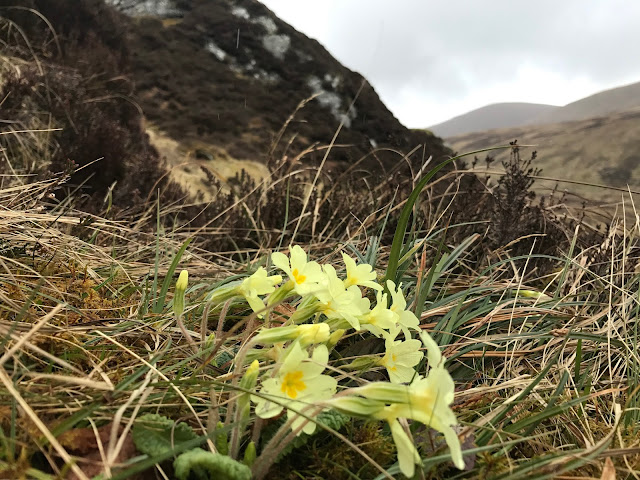After a fantastic week in Sweden, I flew over to Scotland where I met up with Carly Epping, also a Diana Aitchison fund student, around 2pm on Friday. We traveled by train up to Perth where we met Julia Corden who was busy setting up for Saturday's SRGC alpine show. Julia drove us to her home in idyllic Scottish town called Pitlochry. The double rainbow and snow dusted mountains in the morning looked like a water color painting.

We spent all day Saturday in Perth for the SRGC show where I had the privilege of guest judging with Ian Christie and Ron Mcbeth. It was a lot of fun to talk plants and reconnect with many familiar faces from my trip 2 years ago. Plant shows are unfortunately uncommon in the US. I find them very valuable for networking, community, and spreading knowledge and passion for growing new or rare plants. I hope the tradition continues for years to come and maybe makes its way to the states.
 |
| The judges and Julia |

 |
| Carly stewarding at her first show ever |
 |
| Cyril receiving his 56th George Forrest award for Saxifraga aretioides |
On Sunday we woke rainy and cold weather but it did not deter us from the day's plans. We were going to the land of Erythroniums, Trilliums, and red squirrels called Cluny Gardens. When we arrived, we were unsure if anyone was around but to our luck, the rain started to let up and John Mattingly popped out and proceeded to give us a 5 star, 2.5 hour tour.
 |
| John showing us the nursery of unusual Primulas and other woodlanders |
Cluny Gardens is an absolute must see garden if you like unusual woodland plants and the peace and quiet of the beautiful Scottish country side. We couldn't have arrived at a better time to see
Erythroniums, Trillium, and
Primula.
 |
| a sea of Erythroniums |
 |
| Trillium chloropetalum |

Cluny was created by Bobby and Betty Masterton. When they arrived in the 1950s there were a few trees – conifers, beeches and oak, but more notably the two giant Sequioas. One of them is Britain’s widest conifer, with a girth of 11 metres. When the Masterson's passed on, John and his wife, Wendy Matingly, took over. The gardens is home to many Himalayan plants such as Meconopsis, Primula and the mahogony bark of Tibetan cherry. As we descended down the hillside, every winding path and corner was full of surprises. I noticed there were no labels which brought about a new feel that this was a different kind of garden and made you appreciate its natural look. Many paths have been closed off because of plants spreading and seeding around freely. The cherry on top for me is that Wendy and John strongly believe in gardening 100% organic. Their leaf compost is the perfect growing media for almost everything that grows in the gardens and there is no shortage of leaves.
 |
| Sequoiadendron giganteum |
 |
| John, Cluny house, old path, and Tibetan cherry |
 |
| The march of the Erythroniums |
 |
| Many Arisaemas were just starting to grow |
 |
| Primula kisoana var. alba |
 |
| Leaf compost is the trick to growing many of these woodland plants |
Another special attraction to the gardens is the population of red squirrels which are very fun to watch.
After the exclusive tour of Cluny, we drove further into the highlands where we stopped for soup and warmed up before ascending into Saxifraga oppositifolia territory.
Seeing so many amazing gardens has been incredible but nothing beats seeing alpines in their native habitat. As we drove higher up the mountain, the landscape became more and more dramatic. We stopped a few times before reaching a dam surrounded by cliffs at the bottom of Ben Lawers.
 |
| Matt, Patrick, and Julia hunting for Saxifragra oppositifolia |
It wasn't long before we found our first couple of plants and they did not disappoint. There were hundreds, many in full flower scattered on the beach and hanging off wet rocks by the stream. Naturally I made my way up the mountain looking for more and before I knew it I was on top overlooking the highlands and taking in their pure beauty. At the top there was many more Sax's and other plants such as Anemone nemorosa and Primula vulgaris.
I can't thank Julia enough for such an amazing experience and weekend. I am in Edinburgh now working at the Botanics. Thank you for reading.




























Comments
Post a Comment